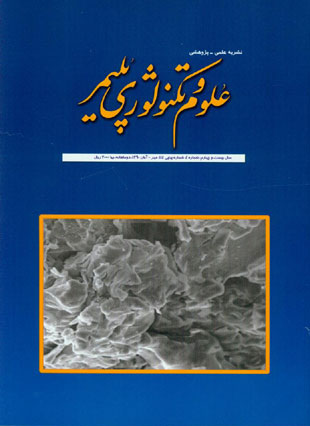فهرست مطالب

دو ماهنامه علوم و تکنولوژی پلیمر
سال بیست و چهارم شماره 4 (پیاپی 114، مهر و آبان 1390)
- تاریخ انتشار: 1390/08/30
- تعداد عناوین: 6
-
-
Page 255Fiber reinforced composites are widely used instead of traditional materials invarious technological applications. Therefore, by considering the extensiveapplications of these materials, a proper knowledge of their impact behavior(from low- to high-velocity) as well as their static behavior is necessary. In order tostudy the effects of strain rates on the behavior of these materials, special testing machinesare needed. Most of the research efforts in this field are focused on applicationof real loading and gripping boundary conditions on the testing specimens. In this paper,a detailed review of different types of impact testing techniques and the strain ratedependence of mechanical and strength properties of polymer composite materialsare presented. In this respect, an attempt is made to present and summarize the methodsof impact tests and the strain rate effects on the tensile, compressive, shear andbending properties of the fiber-reinforced polymer composite materials. Moreover, aclassification of the state-of-the-art of the testing techniques to characterize compositematerial properties in a wide range of strain rates are also given.
-
Page 279Residual lignin of wood after MWL isolation was dissolved with 1-butyl-3-methylimidazolium chloride ionic liquid. Chemical structure of isolatedMWL from poplar wood (Popolus deltiodes) and dissolved residual ligninwere characterized with gas chromatography and 1D, 2D NMR techniques. Analyticalresults showed that Popolus deltoides wood has more 4-(3-hydroxy-1-propenyl)-2-methoxy phenol units (Guayacil lignin) than 4-(3-hydroxy-1-propenyl)-2,6-dimethoxyphenol units (Syringyl moieties). In addition to Guayacil and Syringyl, the extractedligin is composed of a small amount of p-benzyl alcohol. The residual lignin is mainlycomposed of condensed structures which are often of carbohydrate complexes.The lignin structural ratios of dissolved wood in ionic liquid are the same as those ofdioxan extracted lignin. Anomeric HSQC analysis of lignin showed that the lignincarbohydrate complex is composed of cellulose, xylan, mannan and arabinan sugars. Side-chain region of lignin structure is mainly composed of β-O-4, phenylcoumaran, resinol and spirodienone moieties
-
Page 291Synthetic water soluble acrylamide-based polymers have wide range of applicationsin the field of soil establishment and non-desertification. In thisresearch, the acrylamide-based anionic polyelectrolytes were prepared bysolution polymerization. The polymerization was carried out using AIBN as a radicalinitiator and at different degrees of anionic charges ranging between 10% and30% using sodium hydroxide as hydrolyzing agents. The chemical structure of thesynthetic polymers was studied and confirmed by FTIR technique. The charge densityon polymer backbone was determined by titration method. The rheological behaviorof polymer solutions was evaluated by Brookfield viscometer. The results show thatthe viscosity decreases with increasing the shear rate of solutions. Molecular weightsof samples were measured by laser light scattering analyzer. The morphology of thepolymer was studied by SEM and the EDX was used for elemental analysis determination.The anionic polymers with 10-30% negative charges were mixed with clay inorder to evaluate the soil establishment. The results show that an anionic polyelectrolytecan make soil particles more cohesive and improve soil physical properties
-
Page 301
A linear low density polyethylene (LLDPE) production process, includingtwo- fluidized bed reactors in series (FBRS) and other process equipment,was completely simulated by Aspen Polymer Plus software. Fluidizedbed reactors were considered as continuous stirred tank reactors (CSTR consisted ofpolymer and gas phases). POLY-SRK and NRTL-RK equations of state were used todescribe polymer and non-polymer streams, respectively. In this simulation, a kineticmodel, based on a double active site heterogeneous Ziegler-Natta catalyst was usedfor simulation of LLDPE process consisting of two FBRS. Simulator using this modelhas the capability to predict a number of principal characteristics of LLDPE such asmelt flow index (MFI), density, polydispersity index, numerical and weight averagemolecular weights (Mn,Mw) and copolymer molar fraction (SFRAC). The results ofthe simulation were compared with industrial plant data and a good agreement wasobserved between the predicted model and plant data. The simulation results showthe relative error of about 0.59% for prediction of polymer mass flow and 2.67% and0.04% for prediction of product MFI and density, respectively
-
Page 317The present work reports and discusses the results of a 3D simulation of the injectionmolding process of a rubber compound that includes the mold fillingstage and material curing, using the computer code is developed in “UDF”part of the Fluent 6.3 CAE software. The data obtained from a rheometer (MDR 2000)is used to characterize the rubber material in order to find the cure model parameterswhich exist in curing model. Because of non-newtonian behavior of rubber, in thiswork the non-newtonian model for viscosity was used and viscosity parameters werecomputed by mean of viscometry test by RPA. After calculation of the physical andcuring properties, vulcanization process was simulated for a complex rubber articlewith non-uniform thickness by solving the continuity, momentum, energy and curingprocess equations. Predicted filling and curing time in a complex and 3D rubber partis compared with experimentally measured data which confirmed the accuracy andapplicability of the method.
-
Page 329This research work is devoted to the investigation on the use of silica on thefatigue-to-failure property of a tire tread compound. A reference compoundwas first designed in which 60 phr carbon black was used as the reinforcingfiller. While keeping the total of filler content to be constant as 60 phr, three additionalcompounds with 5, 10 and 20 phr silica were then manufactured. The classical staticand dynamic tests were carried out on appropriate samples made from these compoundsto determine tensile strength, hardness, abrasion resistance, fatigue-to-failure,dynamical-mechanical properties and temperature rise due to heat build-up. Theresults showed that by replacing part of carbon black with equivalent amount of silica,a major increase in fatigue resistance is obtained to the point that 20 phr silica hasthe most significant effect when subsituting 5 and 10 phr silica. The DMTA analysesrevealed that the best compromise between fatigue properties, rolling resistance andwet/ice traction can be achieved at 5 to 10 phr silica substitution

